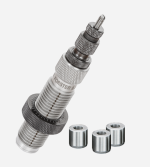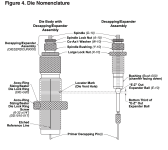Thanks, sorry I don't have a mentor whose experienced with these fancier tools. I can see how separate mandrels might be used to open up the neck a little after resizing, since you can choose the size of the mandrel. It just doesn't make sense when you are using a permanent size expander ball inside a die that utilizes adjustable neck bushing sizes.
The more you move material the more it wants to spring back and resist sizing. So for every 4 steps forward there is one step back. How large that step back depend on several variables in combination.
Using a .288, .289, .290 bushings will all produce varying amounts of interference fit after they have been run over the expander ball.
An expander ball by general rule of thumb will be .002 under the bullet diameter, same dimension as the default recommendation of .002 under mandrel, aka turning arbor, for the mandrel if one so chooses to exchange the ball for a mandrel.
When you side the case neck down down it wants to spring back towards its fired state. If you choose a bushing that gives you the desired amount of interference fit you can leave it here. With good brass or neck turning this is a viable approach. You just need to choose the bushing accordingly.
If your brass is not consistent with a few thousandths differences in neck thickness (crap brass) then this bushing only approach could mean that some cases get too much interference fit on the bullet and some may not get any at all.
Lapua alpha etc will be good and consistent and allow for bushing only- range pick up junk is not a safe bet.
If your brass isnt consistent (what mass manufactured die makers must insure against) then what you do is you size it all down more than strictly necessary and then open it back up. The general population doesnt want to do two handling steps so you put the expander ball in the die and you size it down more than necessary and then open it back up in one press cycle so that they are all the same nominal size to accept the bullet.
Some view that bushing only external forces only imparted on the case as pushing the imperfections towards the inside as the force outside makes the outside even in circumference, with the imperfections in thickness pushed in on the inside of the case neck. Thus an expansion step is necessary to impart force on the inside of the neck back out and create an even circumference for the bullet to interface against.
The more you over work the brass the more stress you induce, the more stress there is the more spring back you get. (annealing helps relax that built up the stress in the material) Thus you can choose a bushing that reduces the over working of your chosen brass but still makes it small enough to make use of the expander ball and get an even presentation on the bullet in one press cycle.
You can get expander balls in sizes from whidden or some others sell over sized balls and allows you to sand them down in a drill to your desired size.
BUT that expander ball puts tension on the case as its dragged out of the as its neck expanding the material.
Brass as a material alone as well as in combination with the cases geometry, is easier to stretch and bend than it is to compress and crush.
So, instead of dragging the expander ball out and stretching on the case, you can remove the ball and force a mandrel down into the case to expand the material where the case is much more able to withstand the forces pushing down on it and resist stretching.
Additionally the mandrel is a much longer bearing surface meaning the case neck material is held at the consistent diameter for much longer than when the expander ball momentarily passes through on its way out.
It just requires twice the amount of press handle pulls on a single stage press.



